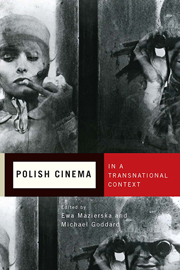Book contents
- Frontmatter
- Contents
- Acknowledgments
- Introduction: Polish Cinema beyond Polish Borders
- Part One The International Reception of Polish Films
- Part Two Polish International Coproductions and Presence in Foreign Films
- 6 Postcolonial Heterotopias: A Paracinematic Reading of Marek Piestrak's Estonian Coproductions
- 7 Poland-Russia: Coproductions, Collaborations, Exchanges
- 8 Train to Hollywood: Polish Actresses in Foreign Films
- 9 Polish Performance in French Space: Jerzy Radziwiłowicz as a Transnational Actor
- 10 Polish Actor-Directors Playing Russians: Skolimowski and Stuhr
- Part Three Émigré and Subversive Polish Directors
- Selected Bibliography
- List of Contributors
- Index
7 - Poland-Russia: Coproductions, Collaborations, Exchanges
from Part Two - Polish International Coproductions and Presence in Foreign Films
Published online by Cambridge University Press: 05 April 2014
- Frontmatter
- Contents
- Acknowledgments
- Introduction: Polish Cinema beyond Polish Borders
- Part One The International Reception of Polish Films
- Part Two Polish International Coproductions and Presence in Foreign Films
- 6 Postcolonial Heterotopias: A Paracinematic Reading of Marek Piestrak's Estonian Coproductions
- 7 Poland-Russia: Coproductions, Collaborations, Exchanges
- 8 Train to Hollywood: Polish Actresses in Foreign Films
- 9 Polish Performance in French Space: Jerzy Radziwiłowicz as a Transnational Actor
- 10 Polish Actor-Directors Playing Russians: Skolimowski and Stuhr
- Part Three Émigré and Subversive Polish Directors
- Selected Bibliography
- List of Contributors
- Index
Summary
In the period following the collapse of communism, when government sources for funding native film production throughout Eastern Europe shrank to very low levels, filmmakers throughout the region turned to international coproductions as the most viable option for securing their craft's continued existence. In Poland some of the most established and promising film directors, such as Andrzej Wajda, Agnieszka Holland, and Krzysztof Kieślowski, found their producers in Western Europe. In the case of the latter two, the conditions of foreign coproductions impacted their works so significantly that the collaborations may be said to have amounted to fundamental turning points in their respective careers. At the same time, Russian film directors were increasingly relying on Western, primarily French, production companies for the funding of their projects. The political and, more importantly, cultural connections that had existed between Poland and the Soviet Union prior to 1989 ceased to provide any sort of link between the two national cinemas in the postcommunist era. On the level of representation, stereotypical portrayals of Russians in Polish cinema, and vice versa, that harked back to the pre– World War II period started to gradually dominate Polish and Russian screens. Since the collapse of communism in Poland, Polish film directors have been successfully casting Russian actors at a rate that may actually have exceeded their presence in Polish films of the communist era. But only one film, Krzysztof Zanussi's Persona Non Grata (2005), has presented an example of a Polish-Russian coproduction that went beyond casting and approximated the type of collaboration that occasionally brought Polish and Soviet filmmakers together in the previous era.
- Type
- Chapter
- Information
- Polish Cinema in a Transnational Context , pp. 134 - 152Publisher: Boydell & BrewerPrint publication year: 2014

